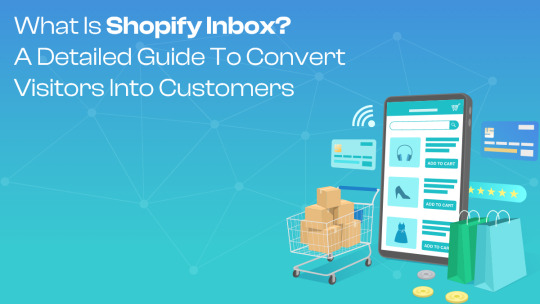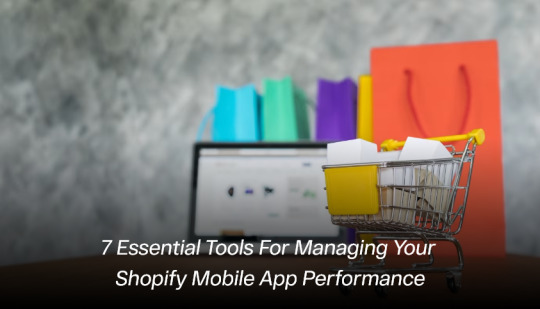#inbox shopify
Explore tagged Tumblr posts
Text
What Is Shopify Inbox? A Detailed Guide To Convert Visitors Into Customers

In the competitive world of e-commerce, engaging with your customers efficiently is crucial. Shopify Inbox offers a powerful solution to convert visitors into loyal customers. In this guide, we will delve into what Shopify Inbox is, its features, and how it can help you enhance your customer service and boost sales.
What is Shopify Inbox?
Introduction to Shopify Inbox
Shopify Inbox is a messaging app integrated into the Shopify platform that allows merchants to communicate directly with their customers. It consolidates all customer conversations from different platforms into a single interface, making it easier to manage inquiries, provide support, and ultimately drive sales.
Key Features of Shopify Inbox
Centralized Communication
One of the standout features of Shopify Inbox is its ability to centralize communication. Whether your customers are reaching out via your online store, social media, or email, all messages are funneled into one place. This ensures that no query is missed and you can respond promptly.
Automated Responses
Shopify Inbox includes automated response features that can handle common inquiries. This not only saves time but also ensures that customers receive immediate responses, enhancing their shopping experience.
Customizable Chat Widget
The customizable chat widget can be tailored to match your store's branding. You can choose the colors, text, and placement to ensure it blends seamlessly with your site’s design.
Integrated Product Recommendations
Another powerful feature is the ability to integrate product recommendations within your chat. You can suggest products directly to customers based on their inquiries, making it easier to upsell and cross-sell.
Analytics and Insights
Shopify Inbox provides valuable analytics and insights into your customer interactions. You can track response times and customer satisfaction and identify common questions to continually improve your service.
How to Set Up Shopify Inbox
Getting Started with Shopify Inbox
Setting up Shopify Inbox is a straightforward process that can significantly enhance your customer service capabilities. Here’s a step-by-step guide to get you started.
Step 1: Install the App
To begin, navigate to the Shopify App Store and search for Shopify Inbox. Click on the app and follow the prompts to install it on your store.
Step 2: Customize Your Chat Widget
Once installed, you can customize your chat widget to align with your brand. Access the settings in the Shopify Inbox app and adjust the appearance, welcome message, and other preferences.
Step 3: Set Up Automated Responses
Next, configure automated responses for common queries. This can include greetings, order status inquiries, and FAQs. Automating these responses ensures customers get instant replies.
Step 4: Enable Notifications
Ensure that notifications are enabled so that you are promptly alerted to new messages. This helps maintain quick response times, which is crucial for customer satisfaction.
Step 5: Monitor and Analyze Performance
Regularly monitor the performance of your Shopify Inbox. Use the analytics provided to track response times, identify common issues, and gather customer feedback to improve your service.
Benefits of Using Shopify Inbox
Enhancing Customer Engagement
Shopify Inbox offers numerous benefits that can enhance customer engagement and drive sales.
Improved Customer Service
By centralizing communication and providing instant responses, Shopify Inbox improves your overall customer service. Satisfied customers are more likely to return and recommend your store to others.
Increased Conversion Rates
Engaging with customers in real time can significantly increase your conversion rates. When customers receive timely answers to their questions, they are more likely to complete their purchases.
Efficient Team Collaboration
Shopify Inbox allows multiple team members to manage customer inquiries simultaneously. This ensures that no message is left unanswered and helps distribute the workload effectively.
Personalized Shopping Experience
With integrated product recommendations, you can provide a personalized shopping experience. Suggesting relevant products based on customer inquiries can lead to higher sales and customer satisfaction.
Best Practices for Using Shopify Inbox
Maximizing the Potential of Shopify Inbox
To make the most of Shopify Inbox, consider implementing the following best practices.
Be Prompt and Responsive
Quick responses are key to keeping customers engaged. Aim to respond to all inquiries within a few minutes to maintain customer interest.
Use Personalization
Personalize your responses to make customers feel valued. Use their names, reference their past orders, and tailor product recommendations to their interests.
Regularly Update Automated Responses
Keep your automated responses up-to-date with the latest information about your products, promotions, and policies. Regular updates ensure customers receive accurate information.
Train Your Team
Ensure that all team members are trained to use Shopify Inbox effectively. They should be familiar with the features, know how to handle common inquiries and provide exceptional customer service.
Gather and Act on Feedback
Use the insights and analytics from Shopify Inbox to gather customer feedback. Act on this feedback to improve your products, services, and overall customer experience.
Conclusion
Shopify Inbox is a powerful tool that can transform your customer service and boost your sales. By centralizing communication, automating responses, and providing personalized shopping experiences, you can convert more visitors into loyal customers. Unleash the power of Shopify Inbox, the best no-code mobile app builder! Learn how to effortlessly convert visitors into loyal customers with this detailed guide. Implement the best practices outlined in this guide to maximize the potential of Shopify Inbox and take your e-commerce business to new heights.
0 notes
Text
A Real-Life Horse Plinko
Hi all,
You read the title right.
It’s not finished yet, but it’s well on its way. Will it work? No promises. This hellish creation was not meant to exist in real life. So we will keep you updated.

We have a stuffed horse for it, but he too is not finished yet. Many prototypes battle in the plinkoing to see who will come out on top and take the crown as DashCon 2's Official Plinko Horse. (Once again, no promises that it will actually function, but we will certainly try our best.)
Speaking of… would you like to take home The Horse from The Plinko? Good news: now you can.
DashCon 2’s Charity Raffle
DashCon 2 will be selling raffle tickets for $1 CAD each! Buy as many as you like and place them in the box corresponding to whatever prize you’d like to be in the lottery for.
Such prizes include…
A ball pit ball signed by DashCon 2’s special guests: Strange Aeons, the Muppet Joker, Xiran Jay Zhao, and more!
A Thomas Jefferson Miku Binder-patterned vest worn by Abigail Thorne from PhilosophyTube in her upcoming video??? (we are as shocked as you are. Abigail we love you sm)
Signed copies of Iron Widow, Heavenly Tyrant, and Zachary Ying and the Dragon Emperor (Xiran we love you too)
Bookbound copy of My Immortal handmade by DashCon 2 founder Simone (it will be fucked up looking but Ebony would have wanted it that way)
Last but not least: the horse plushie from the plinko, valiant warrior that he is
VirtualDash attendees, never fear! We will be providing online-exclusive charity raffle prizes, like a copy of The Prince signed by Abigail Thorne and a second round of special-guest-signed ball pit balls. Tickets will be purchasable through our Shopify site starting July 5!
VirtualDash
Heads up that DashCon 2 will stop absorbing Eventbrite fees on VirtualDash tickets today!!
If you’re thinking of attending, act now to avoid paying extra!
As always, VirtualDash moderator and panelist applications are still open! So far the applications have been super cool - so many of you have weird and wonderful interests :) VirtualDash has the capacity to accept many more panels than IRL DashCon 2 because we aren’t restricted by venue space, so don’t be shy about applying! Once again, the deadline is Friday, June 20th.
Volunteer Applications
We’ve gotten a lot of questions about volunteer applications, so we’re answering them here. Our volunteer coordinator has been sending response emails on an ongoing basis, and you have 2 weeks to respond to your acceptance before your position is given to someone else, so keep an eye on your inboxes!
More Cosplay Photoshoots!
One more cosplay photoshoot has opened up: Goncharov cosplayers are asked to meet at 2:45 (right after The Duel) in Heritage Garden!
Moreover, Strange Aeons mentioned in her DashCon 2 YouTube video wanting to attend a Weed Smoking Girlfriends cosplay photoshoot, but alas we have no one to run it. If any aspiring weed smoking girlfriends would like to volunteer (or merely indicate their cosplay plans), please message [email protected]!
#dashcon#dashcontwo#dashcon 2#dashcon two#yes this is real#updates#virtual dashcon#horse plinko#this took way too long to make#the horse plush looks so stupid#it's a collection of fucked up limbs#but he is dear to me
576 notes
·
View notes
Text










there will be an extra 6 or more pages to wrap this chapter!
Currently updating 3 times a week (M/W/F) and will reach the end of the comic in february! The goal is to launch a kickstarter for an omnibus :) All Rodney comic : ☆☆GOOGLE SLIDE DOC☆☆ other platforms where you can read rodney: ☞WEBTOONS ☜ ☞ instagram ☜
Tumblr chapters: ch 1 // ch 2 // ch 3 // ch 4 // bonus 1 // ch 5 // ch 6 // ch 7 // BONUS valentine's day // ch 8 // ch 9 // ch 10 // ch 11 pt1 // ch 11 pt2 // ch 12 // ch 12.5 // ch 13 pt 1 // ch 13 pt 2 // ch 14 // ch 15 // ch 16 // ch 17 // ch 18.1 // ch 18.2 // ch19.1 // ch19.2 // ch20 // ch21 // ch22 // ch23 // ch24 // ch25
Please consider buying the books on my shopify or supporting me on ko-fi ! I've also started a SUBSTACK if you wanna get comics directly sent to your inbox. alright OVER AND OUT!
271 notes
·
View notes
Text
Pride Angels Leftovers FAQ









If you missed it, the Pride Angels leftovers are available on Shopify and Etsy now! They'll be available until my shops close for the year December 8 2024. I've been getting a few repeat questions about the Pride Angels merch so thought I'd answer them in a post.
Will the Pride Angels pins be restocked if sold out? This batch of pins will not be restocked if sold out but there's still a few ways to get the designs if you miss them. I am sending a handful of every design to my stockists, they should have them available sometime next year. And I will have the designs with new plating/enamel effects up for preorder in a Backerkit campaign next year, you can follow the project to be notified about them.
What about the stickers and keychains? I will restock only the most popular designs, not all stickers and keychains will be restocked. But again, you can find them with my stockists next year if you miss out.
Is the Pride Angels merch available wholesale? Yes, you can purchase the items wholesale on Faire.
Why isn't X design a pin? Not all the designs got enough orders to be made into pins. They are getting a final chance in the Blood & Holy Water preorder store, if you want to see them made please preorder or share those listings. If they don't get enough orders they will not be made into pins, and you won't be charged for them.
When will your shops reopen? I don't have an exact date but probably sometime January-March 2025. While they are closed you can purchase from my stockists.
Let me know if you have any other questions in the replies or via my inbox. Thanks for supporting Pride Angels 🌈
#pride angels#faq#shop stuff#shop news#pride#angels#eldritch angel#eldritch angels#biblically accurate angel#biblically accurate angels#seraphim#seraph#cherubim#cherub#ophanim#angelcore#angel art#angel pin#angel design#angel oc#lgbt
44 notes
·
View notes
Text
Kindly inbox me via the link and tell me how much you want to pay to get yours done and I will also get you massive sales with proven result

#shopify#etsy store#online store#store#vintage#clothing#clothes#fashion#vintage fashion#jewelry#jewellery#beauty
13 notes
·
View notes
Text






🌸 The season of growth and renewal is here—are you ready to meet it with clarity and intention?
I'm offering 20% off on three of my Renewal-Based Tarot Readings, available only on my Shopify store. Each reading is designed to help you move with the wheel of the year and realign your energy with the season’s magic.
🃏 Here’s what’s on the table:
🌿 6-Card Ostara & Spring Equinox Reading: Perfect for witches wanting to align with spring energy. Think: new beginnings, fresh growth, and unearthing the seeds you’ve buried all winter.
🌑 6-Card New Moon Reading + FREE Oracle Card: Centered on intention-setting, shadow work, and receiving clear guidance when the moon is dark and full of possibility.
🔥 7-Card Imbolc Reading: A powerful spread to help you release winter’s weight and ignite your inner fire during this time of sacred rebirth.
🖤 Each reading is intuitively pulled, thoughtfully interpreted, and delivered to your inbox within 72 hours. Whether you're just beginning your tarot journey or deep in your craft, these readings meet you where you are—with honesty and darkly nurturing insight.
This is a limited time sale for the witches who know that real power lies in reflection, intention, and a little divinely timed guidance.
✨ Shop the sale at morriganscrows.com ✨ And don’t forget to sign up for my newsletter for a 15% off code + my Beginner Witch’s Guide to Crystals—a free 14-page e-book to help boost your practice.
#witch community#witchcraft#witchblr#quefefe#witchythings#witch aesthetic#witchy#witch beginner#witch#90’s witch#whimsicore#whimsigoth#whimsiwitch#morrigans crows#beginner witch
2 notes
·
View notes
Text
I will help you with your Shopify issues kindly inbox me let kick start your storee!!!
2 notes
·
View notes
Text
Hiii! Store Buddies.
Wanna build a shopify store but dont know how?
inbox me to get started....
5 notes
·
View notes
Text
2025’s Best Direct Mail APIs for E-commerce and SaaS Businesses

As digital ad costs rise and inboxes overflow, direct mail is making a strong comeback—especially when automated via API. For e-commerce and SaaS businesses in 2025, using a Direct Mail API can unlock personalized offline campaigns with the precision of digital marketing. This guide explores the best APIs tailored for these industries, analyzing their features, pricing, and advantages.
Why Use Direct Mail APIs in 2025?
Omnichannel Consistency
Triggered Automation (abandoned carts, trial expiries)
Personalized Touchpoints
Higher Response Rates
Easy A/B Testing and ROI Tracking
Top Direct Mail APIs for E-commerce & SaaS
1. Lob
Best for: Scalable mail operations Features:
RESTful API
Address verification
Postcards, checks, letters
Real-time delivery tracking
Custom HTML templates Pricing: Starts at $0.73/postcard
2. PostGrid
Best for: Fast deployment, compliance-focused businesses Features:
HIPAA and SOC-2 compliance
Canada & US support
Address validation
Zapier integration
Detailed audit logs Pricing: Custom plans, starts ~$0.70/postcard
3. Click2Mail
Best for: Budget-conscious SMBs Features:
REST API and Zapier
Letters, postcards, flyers
Address cleansing
USPS tracking Pricing: From $0.55/postcard
4. Postalytics
Best for: CRM integration & drip campaigns Features:
HubSpot/Salesforce integrations
Workflow automation
Response tracking
QR code personalization Pricing: Starts free; paid plans from $49/month
5. Inkit
Best for: SaaS compliance + security Features:
Zero-trust infrastructure
Access control & compliance
Works with Snowflake, Segment
Enterprise-ready API Pricing: Enterprise pricing only
API Comparison Table
ProviderTrackingTemplatesZapier SupportMin PriceSecurityLob✔HTML✔$0.73SOC 2PostGrid✔Drag/HTML✔$0.70HIPAAClick2Mail✔Basic✔$0.55BasicPostalytics✔Rich UI✔$0.00GDPRInkit✔Custom✘CustomEnterprise
Key Features for E-commerce
Abandoned cart automation
Purchase-based segmentation
Loyalty offers via mail
Custom QR codes linking to products
Integration with Shopify or WooCommerce
Key Features for SaaS
Free-trial expiry reminders
Churn reduction offers
Onboarding welcome letters
Milestone celebration cards
Integration with CRMs like HubSpot and Pipedrive
Success Metrics
Open Rate: 90%+ (based on USPS studies)
Response Rate: 5-9% average
ROI: Up to 29% higher than email-only campaigns
Retention: SaaS companies report up to 12% churn reduction
Conclusion
Direct Mail APIs are a game-changer for e-commerce and SaaS businesses looking to automate and personalize offline touchpoints. The providers listed above offer scalable, secure, and cost-effective solutions to elevate your 2025 marketing strategy.
youtube
SITES WE SUPPORT
API To Automate Mails – Wix
0 notes
Text
7 Essential Tools for Managing Your Shopify Mobile App Performance

Mobile apps have become crucial to any successful e-commerce business in today's digital landscape. Shopify, a leading e-commerce platform, offers mobile app solutions that allow businesses to connect with their customers on the go. This article explores the importance of managing Shopify mobile app performance and presents seven essential tools and strategies to monitor, optimize, and enhance the performance of your Shopify mobile app. By implementing these techniques, you can maximize user engagement, conversion rates, and overall customer satisfaction.
Introduction to Shopify Mobile App Performance Management
What is Shopify Mobile App Performance?
When we talk about Shopify mobile app performance, we refer to how well your app functions and performs on mobile devices. It includes app load time, response time, error rates, crash frequency, and overall user experience.
Why Is App Performance Management Important?
App performance management is crucial because it directly impacts your customer's experience and your business's success. If your app is slow, crashes frequently, or has errors, users will quickly become frustrated and may abandon your app altogether. By effectively managing your app's performance, you can ensure a smooth and seamless customer experience, increasing satisfaction, engagement, and conversions.
Understanding the Importance of App Performance Optimization
App performance optimization is crucial to developing and maintaining successful software applications. The performance of an application directly impacts user experience, customer satisfaction, and even business success. Here are several reasons why app performance optimization is important:
User Experience for Shopify Stores
Efficient Store Management
A well-optimized Shopify mobile app builder ensures merchants can efficiently manage their online stores on mobile devices. Quick response times and smooth interactions contribute to a positive user experience.
Business Impact
Revenue Generation
For businesses, app performance is directly tied to revenue generation. E-commerce websites, for example, may experience higher conversion rates with faster-loading pages, leading to increased sales.
Competitive Advantage
In competitive markets, users often choose applications that offer the best performance. Optimizing performance can provide a competitive advantage over other applications in the same space.
Resource Utilization
Efficient Resource Usage
Well-optimized applications use system resources more efficiently. It is important for both client-side and server-side applications, as it can reduce hosting costs and improve scalability.
Energy Efficiency
On mobile devices, energy efficiency is crucial. Optimized apps consume less battery power, a significant factor in user satisfaction.
Scalability
Accommodating Growth
As user bases and data volumes grow, an application must be able to scale to handle increased demand. Performance optimization ensures the application can scale effectively without sacrificing speed and responsiveness.
SEO and Visibility
Search Engine Rankings
Search engines consider the speed and performance of websites when ranking search results. Faster-loading pages can positively impact an application's search engine ranking, improving its visibility.
Reduced Maintenance Costs
Bug Reduction
Optimized code tends to have fewer bugs and issues. It reduces maintenance costs and allows developers to focus on adding new features rather than constantly addressing performance-related problems.
User Retention
Long-Term Engagement
Applications consistently delivering high performance will likely retain users over the long term. Users are more likely to return to and recommend applications that provide a positive and reliable experience.
Key Metrics for Measuring Shopify Mobile App Performance
When measuring the performance of a Shopify mobile app developed through Shopify mobile app development, various key metrics can provide insights into the app's effectiveness and user satisfaction. Here are essential metrics to consider:
Page Load Time
The time it takes for a specific page in the Shopify mobile app to load. Faster page load times enhance user experience, reduce bounce rates, and contribute to higher conversion rates.
App Responsiveness
The speed at which the app responds to user interactions, such as clicks or swipes. A responsive app ensures a smooth and enjoyable user experience, preventing frustration and encouraging continued engagement.
Conversion Rate
The percentage of users who complete a desired action (e.g., making a purchase) out of the total number of app visitors. A high conversion rate indicates that the Shopify mobile app effectively guides users through the conversion funnel, resulting in business success.
Session Duration
The average time users spend within the Shopify mobile app during a single session. Longer session durations often indicate that users find value in the app and are engaged with its content and features.
Retention Rate
The percentage of users who return to the app after their initial visit. A high retention rate signifies user satisfaction and the app's ability to retain its audience over time.
Error Rate
The frequency of errors or crashes within the Shopify mobile app. A low error rate ensures a stable and reliable app experience, reducing user frustration and potential app abandonment.
Average Order Value (AOV)
The average monetary value of orders placed through the Shopify mobile app. Monitoring AOV helps gauge the app's effectiveness in driving higher-value transactions and maximizing revenue.
User Engagement
Metrics such as the number of app visits, interactions, and feature usage. Understanding user engagement patterns helps refine the app's content and features to meet user needs and preferences better.
Loading Performance Across Devices
Analyzing the Shopify mobile app's performance on various devices and screen sizes. Ensuring consistent performance across different devices is crucial for providing a positive user experience to a diverse audience.
Regularly monitoring and analyzing these key metrics for a Shopify mobile app developed through Shopify mobile app development is essential for ongoing improvement, user satisfaction, and the application's overall success.
Techniques for enhancing app speed and responsiveness
Optimizing app speed and responsiveness is crucial to providing a positive user experience when working with a Shopify mobile app template. Here are several techniques to enhance the speed and responsiveness of a Shopify mobile app using a template:
Optimized Images
Compress and optimize images used in the app to reduce file sizes without compromising quality. Large image files can significantly slow down app loading times. Optimizing images ensures faster loading without sacrificing visual appeal.
Caching Strategies
Implement caching mechanisms for static resources like images, stylesheets, and scripts to reduce load times for returning users. Caching minimizes the need to re-download resources on subsequent visits, enhancing overall app performance.
Optimized Codebase
Review and optimize the Shopify mobile app template's codebase, eliminating unnecessary code and improving efficiency. Well-optimized code contributes to faster execution, rendering, and overall app responsiveness.
Reduced HTTP Requests
Minimize the number of HTTP requests by combining CSS and JavaScript files and reducing the use of external resources. Each HTTP request adds latency to the loading process. Reducing requests helps streamline the app's loading speed.
Mobile-First Design
Implement a mobile-first design approach, prioritizing delivering essential content and features for mobile users. Focusing on mobile users ensures the app is optimized for smaller screens and limited bandwidth, improving overall performance.
Progressive Web App (PWA) Features
Implement PWA features like service workers to enable offline functionality and faster loading on subsequent visits. PWAs provide a more app-like experience, allowing users to access content offline and improving overall responsiveness.
By incorporating these techniques into the development process of a Shopify mobile app using a template, developers can significantly enhance app speed and responsiveness, leading to a more positive user experience and increased satisfaction among app users.
Strategies for Optimizing App User Experience
When converting a Shopify store to a mobile app, optimizing the user experience is essential for customer satisfaction and business success. Here are strategies to enhance the app user experience in the context of converting a Shopify store to a mobile app:
Responsive Design
Ensure the mobile app has a responsive design that adapts seamlessly to various screen sizes and orientations. Responsive design guarantees users a consistent and visually appealing experience, regardless of their device.
Intuitive Navigation
Design an intuitive navigation structure that makes it easy for users to browse products, navigate categories, and access essential features. Simplifying navigation enhances user engagement and helps users quickly find what they want, improving the overall user experience.
Optimized Product Display
Present product information in a clear and visually appealing manner. Use high-quality images, concise descriptions, and intuitive product layouts. Optimized product displays create a compelling shopping experience, encouraging users to explore and purchase.
Efficient Search Functionality
Implement a robust search feature with filters and sorting options to help users easily locate specific products. A powerful search function accelerates the shopping process, making it more convenient for users to find and purchase items.
Seamless Checkout Process
Streamline the checkout process by minimizing steps, offering guest checkout options, and integrating secure payment gateways. A seamless and user-friendly checkout process reduces cart abandonment rates and improves the likelihood of successful transactions.
Personalization Features
Incorporate personalization features, such as product recommendations based on user preferences and previous purchases. Personalization enhances user engagement, making the shopping experience more tailored and enjoyable for individual users.
Push Notifications
Utilize push notifications to notify users about promotions, discounts, and updates related to their favorite products. Well-timed and relevant push notifications can increase user engagement and drive repeat visits to the app.
Loading Speed Optimization
Optimize app loading speed by compressing images, minimizing HTTP requests, and employing efficient coding practices. Faster loading times contribute to a positive first impression, reducing bounce rates and improving overall user satisfaction.
Customer Feedback and Support
Implement feedback mechanisms and provide accessible customer support channels within the app. Gathering user feedback and offering prompt support enhances the overall user experience, demonstrating a commitment to customer satisfaction.
Security Measures
Prioritize security by implementing secure authentication methods and ensuring the protection of user data. Security measures build trust with users, assuring them that their personal and financial information is safe when using the mobile app.
By incorporating these strategies when convert Shopify store to mobile app, businesses can create a user-centric and engaging experience, leading to higher customer satisfaction, increased conversions, and long-term loyalty.
Wrapping Up
By incorporating these essential tools into your performance management strategy, particularly when using a mobile app builder, you can proactively address issues, optimize user experience, and ensure the success of your Shopify mobile app in the competitive e-commerce landscape. Regular monitoring and optimization are key to maintaining a high-performing, customer-friendly mobile application.
#shopify mobile app#shopify mobile app builder#shopify app builder#mobile app builder for shopify#convert shopify store to app#shopify inbox#mobile app builder
0 notes
Text
Outsourced VAT compliance audit service for companies

Outsourced VAT Compliance Audit Service for Companies: Why It's Not Just About Saving Time Let’s be real—when you hear the word "audit," your brain probably flashes to spreadsheets, legal disclaimers, and the silent panic of a misplaced invoice from six months ago. Totally fair. But when it comes to outsourced VAT compliance audits, especially in the UK or across the EU, the conversation needs to shift from “what we have to do” to “what we should be doing.”
Because here’s the truth: VAT errors aren’t just annoying—they’re expensive, reputation-wrecking, and, more often than not, completely avoidable.
Why Bother Outsourcing VAT Audits in the First Place? Outsourcing gets a weird rap sometimes. People think it means giving up control or offloading things you don’t care about. But with VAT compliance, it’s actually the opposite.
You’re not passing the buck. You’re pulling in the cavalry.
When you outsource a VAT audit service, you're tapping into a team that lives and breathes tax law, changes, exemptions, and edge cases you didn’t even know were cases. And instead of reacting to problems, you get ahead of them.
Especially for:
Startups who don't have an internal finance department yet, SMEs juggling local and international growth, Enterprises that operate across multiple VAT jurisdictions, And marketing teams (yes, marketing!) launching promotions that might have unexpected VAT implications… …outsourcing isn’t just helpful—it’s kind of essential.
Let’s Talk About Time, Sanity, and Specialist Insight Here’s the thing: your internal team, no matter how good they are, probably wears too many hats. One week it’s month-end close. The next, it’s budgeting. Somewhere in the middle, someone’s supposed to double-check if that German digital services invoice applied the correct reverse charge rule?
Yeah. No.
An outsourced VAT compliance audit partner handles all of that—without clogging up your inbox or calendar. They bring the time, the talent, and most importantly, the focus that your team just doesn’t have room for.
And the good ones? They don’t just plug numbers into boxes. They tell you the story behind the data—where you’re exposed, what to fix, and how to prevent repeat issues.
Still Think You’ve Got It Covered In-House? Quick Reality Check. Let me throw out a few questions:
Have you registered for VAT in every country you sell to digitally? Are you sure all your invoices comply with both local and international VAT rules? Do you apply the correct rate when bundling services or running promotional discounts? Has anyone on your team double-checked that your supply chain isn’t triggering unwanted VAT obligations? If you’re even hesitating, then yeah—outsourcing your VAT audit might be the smartest thing you do this quarter.
Not All VAT Audit Providers Are Created Equal Some services focus solely on plugging in software, scanning your ledgers, and generating a generic compliance report. That might work for businesses with a very straightforward model—but let’s face it, those are rare.
If you’re dealing with:
Digital goods, Subscription-based pricing, Shipping across borders, Invoicing in multiple currencies, Or selling on marketplaces like Amazon, Etsy, or Shopify… …you need a service that can handle nuance.
So, what separates a decent service from a really solid outsourced VAT audit partner? They get into the weeds (and know how to climb back out) They talk like humans, not tax bots They work with your existing systems, not around them (think integrations with Xero, Sage, NetSuite, etc.) They don’t treat you like every other client—because your business model probably isn’t
Rapid Business Solution: One Worth Looking At If you’ve been poking around for a reliable VAT audit service, Rapid Business Solution is probably already on your radar—and if not, they should be.
They’ve built a name around working with everyone from micro-startups to global B2B SaaS companies, helping businesses navigate VAT territory with minimal stress. And what's refreshing? They don’t come in swinging red flags. They come in asking the right questions.
Their outsourced VAT audits are thorough, but also friendly (yes, friendly tax people exist). They flag issues, offer clear steps to resolve them, and—here’s the kicker—they’ll even walk your team through how to avoid similar hiccups in the future.
No fearmongering. No bloated reports. Just clarity and action.
Why Marketing and Sales Shouldn’t Be Left Out of This Here’s something people miss: VAT compliance doesn’t stop at finance. Marketing teams that run offers across different geographies need to be clued in. Sales teams quoting prices need to know if VAT is included or added. Even product teams creating bundles can trip compliance wires.
When you outsource VAT audits, good providers loop in all the right departments—not just the finance team. That makes campaigns smoother, pricing more transparent, and customer trust a whole lot easier to earn.
So yeah, marketers, you should care.
Startups: Get It Right Early or Regret It Later You know that thing where you leave something messy “just for now,” and then three years later, it’s a monster problem? Yeah. VAT is like that.
Startups don’t need a full-time tax department, but they do need clarity. An outsourced VAT audit gives you exactly that—before your first investor due diligence call, before your first international sale, before HMRC notices anything off.
It’s like brushing your teeth—do it early and often, or pay later.
Enterprises and SMEs: Complexity Is Not a Badge of Honour The more you grow, the more complex your VAT becomes. Group VAT registrations. Mixed-use assets. Place of supply rules. Deemed supplies. (Seriously—what are those?) It piles up fast.
For enterprises and SMEs, regular VAT audits aren’t just a box to tick. They’re the difference between confident scaling and tax chaos.
Outsourcing this helps you:
Catch errors before HMRC does Prove due diligence in case of an inspection Simplify internal workflows And keep your sanity intact
Let’s Talk Pricing and Trust (Because Those Matter, Too) Outsourcing always sparks the "is it worth it?" debate. But compared to penalties, lost input tax, or reputation damage? The cost of a VAT audit is basically peanuts.
Just make sure you're getting what you pay for:
Transparent pricing Clear deliverables Human support And zero hidden fees or lock-ins Trust matters. You’re giving someone access to your financial DNA—they better treat it with care.
So, Is It Time to Outsource Your VAT Audit? If you’re still debating, ask yourself this:
“Do I know, with absolute certainty, that we’re VAT compliant across all our activities?”
If the answer is no—or even “I think so?”—then it’s time.
Whether you’re a lean startup trying to avoid rookie mistakes or a seasoned business juggling cross-border sales, outsourcing your VAT audit to a team like Rapid Business Solution could be the smartest move you make this year.
Because honestly? You’ve got enough to manage. Let someone else worry about HMRC. Follow this website rapid business solution: https://rapidbs.ae/
0 notes
Text










there will be an extra 2 or 3 page to wrap this chapter!
Currently updating 3 times a week (M/W/F) and will reach the end of the comic in february! The goal is to launch a kickstarter for an omnibus :) All Rodney comic : ☆☆GOOGLE SLIDE DOC☆☆ other platforms where you can read rodney: ☞WEBTOONS ☜ ☞ instagram ☜
Tumblr chapters: ch 1 // ch 2 // ch 3 // ch 4 // bonus 1 // ch 5 // ch 6 // ch 7 // BONUS valentine's day // ch 8 // ch 9 // ch 10 // ch 11 pt1 // ch 11 pt2 // ch 12 // ch 12.5 // ch 13 pt 1 // ch 13 pt 2 // ch 14 // ch 15 // ch 16 // ch 17 // ch 18.1 // ch 18.2 // ch19.1 // ch19.2 // ch20 // ch21 // ch22 // ch23 // ch24
Please consider buying the books on my shopify or supporting me on ko-fi ! I've also started a SUBSTACK if you wanna get comics directly sent to your inbox. alright OVER AND OUT!
349 notes
·
View notes
Text

I will Set Up High-Converting e-commerce Email Marketing Flows in Klaviyo.
Visit My Upwork Project:
Klaviyo On Upwork
Supercharge your eCommerce sales with expertly designed Klaviyo email automation flows!
As a dedicated Klaviyo email marketing specialist, I help online stores like yours set up powerful email flows that turn visitors into buyers and one-time shoppers into loyal customers.
Whether you're on Shopify, WooCommerce, or BigCommerce, I’ll craft custom workflows including welcome series, abandoned cart recovery, post-purchase sequences, win-back campaigns, and more — all optimized for engagement, conversions, and long-term growth.
Each email is professionally written, mobile-friendly, and tailored to reflect your brand's voice. With my strategic segmentation and flow logic, your emails will hit the inbox at just the right time — not the spam folder.
Let’s build your automated revenue machine in Klaviyo. Contact me today and start seeing results!
#klaviyo email marketing#ecommerce email automation#klaviyo flow setup#abandoned cart emails#klaviyo welcome flow#post purchase emails#shopify email marketing#klaviyo expert#email flows setup#email campaign management#browse abandonment flow#klaviyo popup setup#klaviyo segmentation#klaviyo sms marketing#email list management#cart recovery emails#customer retention emails#product recommendation emails#email marketing automation#klaviyo email design#ecommerce retention marketing#trustpilot review emails#email marketing specialist#klaviyo newsletter setup#klaviyo shopify integration
1 note
·
View note
Text
Automate Direct Mail at Scale: How APIs Empower E-Commerce and CRM Systems

In the age of instant gratification and digital dominance, direct mail may seem like a relic of the past. But the truth is, direct mail is experiencing a powerful resurgence — not in its old form, but through modern automation powered by APIs (Application Programming Interfaces). For e-commerce platforms and CRM systems, direct mail APIs offer scalable, personalized, and automated outreach opportunities that drive engagement, increase customer retention, and boost ROI.
This article dives into how direct mail automation through APIs is transforming e-commerce and CRM operations, providing businesses with the tools to deliver impactful offline experiences at digital speed and scale.
What Is Direct Mail Automation with APIs?
Direct mail automation is the process of sending physical mail — such as postcards, letters, catalogs, and self-mailers — through a digital interface that is triggered by events, behaviors, or workflows. With APIs, businesses can integrate this automation into their existing systems, such as CRM software or e-commerce platforms, creating seamless and scalable mail campaigns.
Key Features:
Event-based triggers (e.g., cart abandonment, birthday, renewal)
Real-time printing and mailing
Data-driven personalization
Scalability from one piece to millions
End-to-end tracking and reporting
Why Direct Mail Matters in a Digital Age
While email inboxes overflow and social media ads are skipped or blocked, physical mail continues to command attention. According to the Data & Marketing Association (DMA), response rates for direct mail are 5–9 times higher than digital channels like email and paid search.
Benefits of Direct Mail:
Tangible and personal
Stays in the home longer
Generates trust and credibility
Cuts through digital noise
By combining this effectiveness with API-driven automation, businesses gain the best of both worlds — the reach and speed of digital with the conversion power of physical mail.
How APIs Empower E-Commerce Platforms
E-commerce platforms thrive on fast, data-driven decision-making. Direct mail APIs plug directly into platforms like Shopify, WooCommerce, Magento, and custom-built e-commerce systems to unlock targeted physical communication in real time.
Top Use Cases:
Cart Abandonment Campaigns Trigger postcards or letters to customers who left items in their cart within 24–48 hours.
Post-Purchase Thank Yous Send personalized thank-you notes or discount vouchers to new customers.
Re-Engagement Campaigns Deliver high-quality direct mail to customers who haven’t purchased in 30–60 days.
Seasonal Promotions Automate delivery of holiday catalogs or limited-time offers to segmented audiences.
Benefits for E-Commerce:
Higher recovery rates from abandoned carts
Strengthened brand loyalty
Increased lifetime customer value
Greater upsell and cross-sell opportunities
How APIs Supercharge CRM Systems
For CRM platforms like Salesforce, HubSpot, Zoho, or custom solutions, APIs enable the automation of mailings based on customer segmentation, behavior, or lifecycle stage.
Key Triggers in CRM-Based Campaigns:
Lead Nurturing: Trigger postcards when leads reach a specific score.
Customer Anniversary: Celebrate with personalized mailers.
Customer Churn Risk: Deliver retention offers via mail.
Upselling & Cross-Selling: Use behavioral data to promote relevant products.
Benefits for CRM Integrations:
Enhanced personalization at scale
Decreased churn with timely engagement
Increased customer satisfaction and LTV
Better segmentation and lifecycle marketing
Top Direct Mail API Providers for Automation
Lob – Enterprise-grade print & mail automation for developers and marketers.
PostGrid – Full-stack postal automation API with address verification.
Click2Mail – Offers an API for sending letters, postcards, and documents.
Thanks.io – Focused on real estate and e-commerce personalized mail.
Inkit – Secure and scalable direct mail and document delivery platform.
Technical Overview: How Direct Mail APIs Work
Authentication & API Keys – Secure access to mail automation endpoints.
Data Input – JSON or CSV data with recipient names, addresses, and custom variables.
Mail Template Creation – HTML-based templates or drag-and-drop editors.
Trigger Integration – Connect to CRMs or e-commerce triggers via webhooks or APIs.
Production & Delivery – Mail is printed, sorted, and delivered via USPS or carriers.
Tracking & Analytics – Monitor delivery, opens (QR codes), and response rates.
Compliance and Security in Direct Mail APIs
Many businesses handle sensitive customer data. Direct mail APIs often comply with:
HIPAA (for healthcare)
SOC 2 Type II
GDPR
CCPA
Always ensure your direct mail provider encrypts data, offers role-based access, and stores information securely.
Case Studies: Real-World API-Powered Campaigns
1. E-Commerce Brand Recovers Abandoned Sales
A fashion brand integrated Lob’s API with Shopify. They triggered postcards within 24 hours of cart abandonment, offering a 10% discount. Result: 21% cart recovery rate and 14x ROI on print investment.
2. CRM-Driven Re-Engagement Campaign
A SaaS company using HubSpot automated win-back postcards to trial users. With PostGrid’s API, they triggered a postcard with a personal message and CTA to renew. Churn dropped by 18% in 3 months.
Best Practices for Direct Mail Automation with APIs
Clean Your Address List Use address verification APIs to avoid undeliverable mail.
A/B Test Messages and Designs Use multivariate testing to optimize engagement.
Integrate QR Codes Link printed mail to digital experiences with scannable QR codes.
Segment Deeply Target based on behavior, purchase history, or geography.
Set Up Analytics Track responses, conversions, and delivery to measure ROI accurately.
Conclusion
Direct mail automation using APIs is transforming how businesses engage customers in both e-commerce and CRM systems. By leveraging automation, personalization, and scalability, businesses can create powerful offline experiences at digital speed.
Direct Mail APIs empower your marketing to go beyond the inbox — and directly into your customers’ hands.
youtube
SITES WE SUPPORT
Automated Mailing API – Wix
0 notes
Text
Design Amazon product listing images, product photo editing, and A plus content
Stand Out. Convert More. Sell Better.
Are you struggling to get attention on Amazon? Your product might be amazing, but if your listing doesn't look amazing, you're leaving sales on the table.
Strategic Product Research: Before designing
Why choose me?
10+ years of experience with Amazon listings
2,000+ Orders Completed
1k+ happy clients and proven sales results
Quick, friendly communication and support
Unique, tailored designs that boost sales
Listing Image Optimization
Hero & Main Image
Infographic for product features
Lifestyle image creation
Clear comparison charts
️ A+ Content / EBC Design
Professional EBC templates
Custom graphics
SEO-friendly layouts
Highlight key product features.
Skilled
Expert in Adobe Photoshop & Illustrator, Canva, AI photo editor & PPC.
Served industry
Amazon/Walmart/eBay/Shopify/BOL/Alibaba/Etsy
Product NICHES
Health, Supplements, Beauty, Personal Care, Pets, Electronics, Gym, Toys & Kitchen.
Unlimited revisions until you're satisfied.
Let's take your product images to the next level. Contact me today!
Click Order Now or message me via the inbox.
Thank you for visiting my profile.
Greetings
Touhiduzzaman

#amazon seller#amazon fba#amazon deals#graphic design#100 days of productivity#amazon products#make money online#amazon finds#ecommerce#amazon#design#dropshipping#beauty products#health products#healthcare#visit
0 notes
Text
How to Choose the Right Ecommerce Reporting Software for Your Business Needs
In the fast-paced world of online retail, data is everything. Ecommerce reporting software provides the insights you need to make informed decisions, optimize marketing efforts, and drive growth. But with so many tools on the market, how do you choose the right ecommerce reporting software for your business?
This guide breaks down the key features, considerations, and steps to help you find the perfect fit for your ecommerce needs.
Why Ecommerce Reporting Software Matters
Whether you're a small store owner or running a large ecommerce operation, reporting software can:
Track sales and revenue trends
Monitor marketing campaign performance
Analyze customer behavior
Improve inventory and supply chain management
Provide actionable insights for business growth
With the right tool, you can transform raw data into clear, strategic decisions that enhance your online store's performance.
1. Define Your Business Goals
Before you start shopping for software, define what success looks like for your business. Are you focused on increasing conversions, boosting customer lifetime value, or reducing cart abandonment? Your goals will determine the features you need.
Key Questions to Ask:
What metrics matter most to your business?
Which platforms (Shopify, WooCommerce, Amazon, etc.) do you sell on?
Do you need multi-channel reporting?
2. Identify Must-Have Features
Look for ecommerce reporting tools that offer the right mix of features for your needs. Here are some of the top features to consider:
a. Customizable Dashboards
Get a clear view of your KPIs with dashboards tailored to your business priorities.
b. Integration with Ecommerce Platforms
Ensure seamless integration with platforms like Shopify, BigCommerce, WooCommerce, Magento, and marketplaces like Amazon or eBay.
c. Marketing and Sales Analytics
Track ROAS, customer acquisition costs, funnel performance, and more across channels like Google Ads, Facebook Ads, and email marketing.
d. Real-Time Data Reporting
Make decisions based on up-to-date information with real-time tracking.
e. Automated Reports
Save time by scheduling regular reports to be sent directly to your inbox or team members.
f. Customer Segmentation
Understand your customer base by segmenting data based on behavior, location, purchase history, and more.
3. Consider Ease of Use
The best ecommerce reporting software should be intuitive and easy to use—no coding required. A user-friendly interface allows you and your team to access and interpret data without needing a technical background.
Pro Tip:
Look for platforms that offer drag-and-drop builders and templates to get started quickly.
4. Evaluate Scalability
Choose software that can grow with your business. As your ecommerce store expands, you may need more integrations, higher data volumes, and advanced features. Ensure the tool is scalable and has pricing tiers that align with your future needs.
5. Compare Pricing Plans
Ecommerce reporting tools vary widely in price. Some offer freemium models with limited features, while others charge based on data volume or number of users.
Things to Consider:
Does the software charge per data source or report?
Are there hidden fees for integrations or support?
What is the ROI compared to your current manual reporting process?
6. Look for Strong Customer Support
No software is perfect, and at some point, you'll need support. Choose a vendor with responsive customer service, live chat, comprehensive documentation, and onboarding assistance.
7. Read Reviews and Testimonials
Before committing to a reporting solution, read user reviews on platforms like G2, Capterra, or Trustpilot. Look for recurring pros and cons to understand what to expect.
Conclusion
Choosing the right ecommerce reporting software is a strategic decision that can significantly impact your business performance. By understanding your goals, identifying key features, and evaluating usability, scalability, and cost, you can find a solution that turns your data into a competitive advantage.
Ready to simplify your ecommerce reporting? Explore tools like Whatsdash for an all-in-one dashboard that automates reports, integrates with major ecommerce and marketing platforms, and gives you full visibility into your performance.
#ecommercereportingtool#ecommercereportingsoftware#whatsdash#customdashboard#ecommercereporting#reporting tool#marketing reporting
0 notes